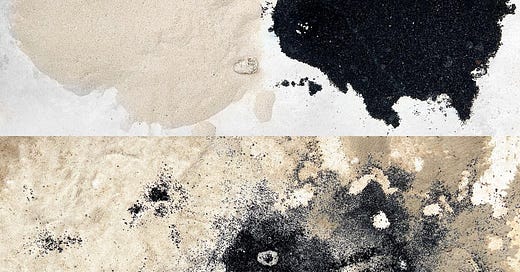Jiabao’s work will be presented in #Essence, part of ART+TECH Festival, in Milan on 3oct
Ha lavorato con il laboratorio di biologia marina Kewalo alle Hawaii. Mentre gli scienziati studiavano i calamari, ha notato che i calamari del laboratorio stavano tutto il giorno nelle noiose vasche bianche. Così si è chiesta se fosse possibile rendere più interessante il loro ambiente costruendo un parco giochi per loro. Ha raccolto la sabbia bianca e la sabbia nera delle isole Hawaii e le ha trasformate nelle forme di alcuni paesi. Mentre il calamaro viveva lì. Trasporta la sabbia da una parte all'altra e la sparge in giro. Nuota avanti e indietro tra i Paesi, attraversando i confini senza visto. Si seppellisce sotto la sabbia e usa i suoi piccoli tentacoli per spingere la sabbia sul suo viso come mimetizzazione. Guardare il calamaro le ha ricordato per molti versi se stessa come immigrata: muovendosi tra la Cina e gli Stati Uniti, portando con sé il bagaglio di due culture, cercando di assimilarsi per mimetizzarsi, si è trovata in questa situazione come il calamaro: ha sabbia bianca sul corpo ma sabbia nera sulla parte superiore, seduto in mezzo al nero circondato dal bianco - ma sentendosi perfettamente mimetizzata.
Costruiamo confini tra i nostri Paesi che possono bloccare le migrazioni naturali degli animali. Gli animali che non si preoccupano della delimitazione tra i Paesi sono costretti a riconoscere la differenza e a schierarsi. Dopo un mese, il calamaro reinterpreta completamente le mappe e i confini costruiti dall'uomo dal punto di vista del calamaro stesso. La mappa per cui gli esseri umani hanno ripetutamente combattuto guerre, agli occhi del calamaro, è disegnata alle loro condizioni.
She worked with Kewalo Marine Biology Lab in Hawaii. While the scientists were studying the squid, I noticed that the squids in the lab sit in the boring white tanks all day long. So I wonder if I could make their environment more interesting by building a playground for them. I collect the white sand and black sand from Hawaii islands and make them into certain countries' shapes. While the squid was living there. He carries the sand from one side to the other and spreads it around. He swims back and forth between the countries, across the borders without a Visa. He buries himself under the sand and uses his cute little tentacles to push the sand on his face as a camouflage. Watching the squid reminds me of myself in many ways as an immigrant: moving between China and the US, carrying the baggage of two cultures, trying to assimilate to blend in, and found myself in this situation like the squid: he has white sand on his body but black sand on the top, sitting in the middle of black surrounded by white -- but feeling perfectly camouflaged.
We build borders between our countries that can block natural animal migrations. Animals that would not care about the delineation between countries are forced to recognize the difference and take a side. After a month, the squid completely reinterprets our human-made maps and borders from the squid's perspective. The map humans have repetitively fought wars for, in the eyes of the squid, is drawn on their own terms.




